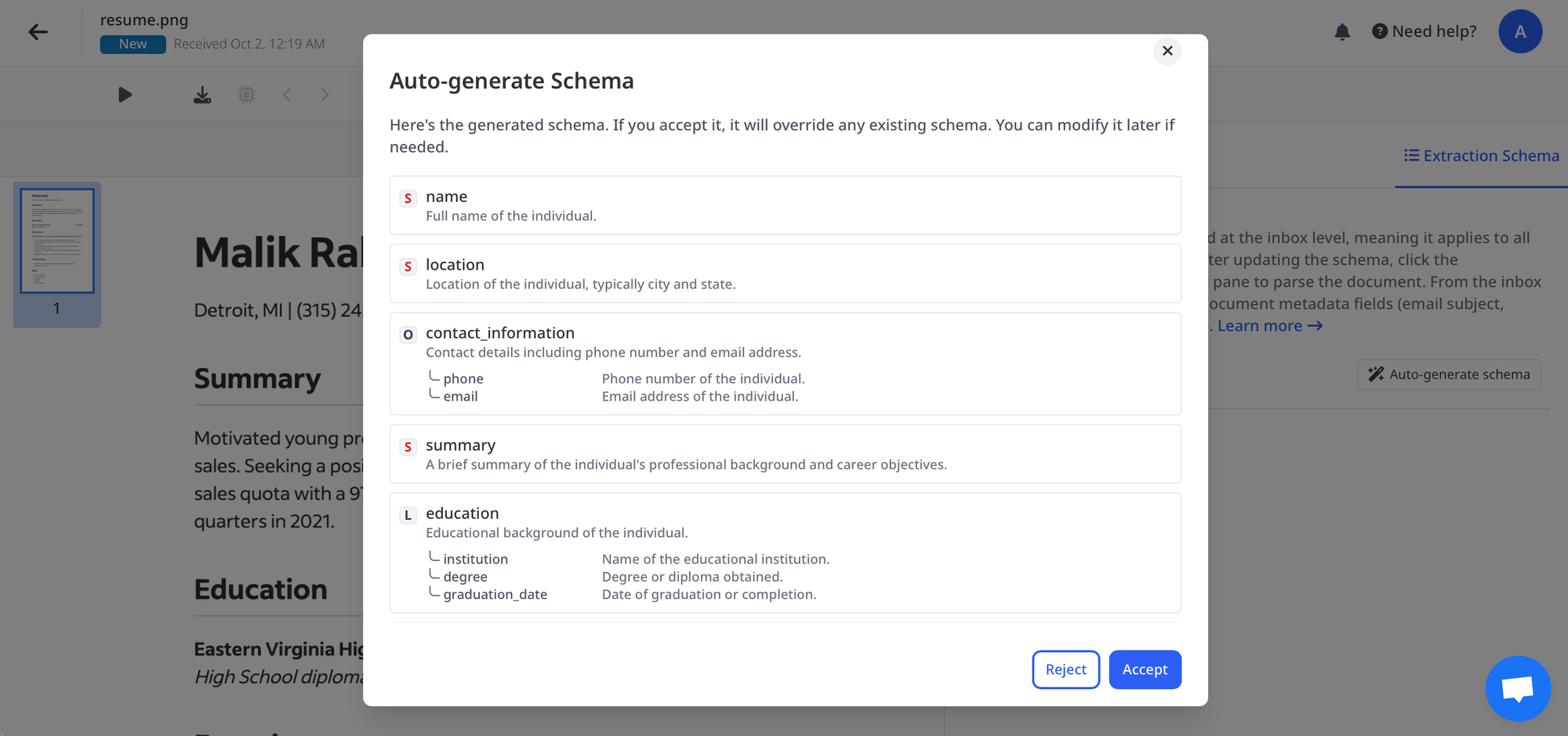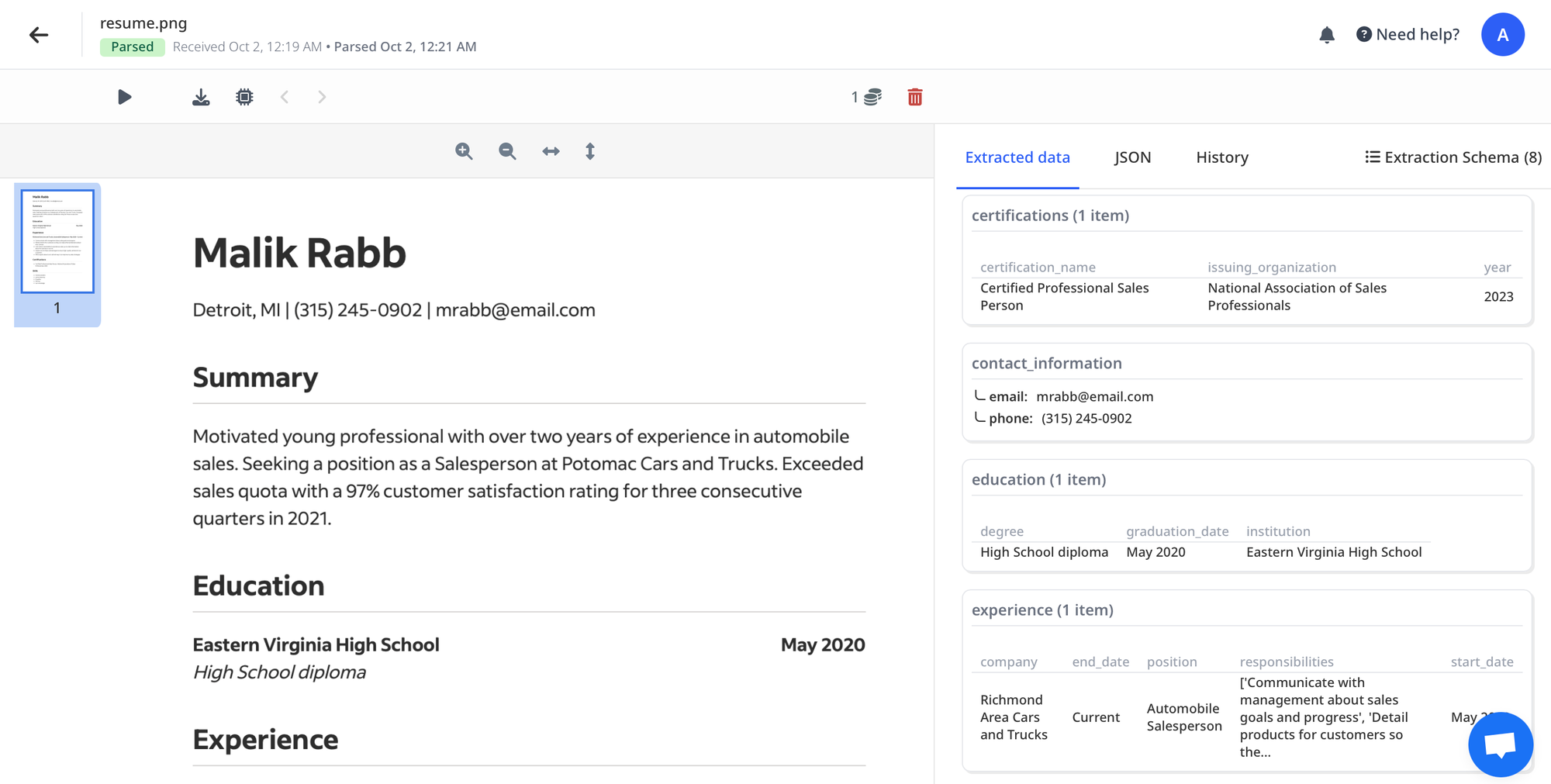Resume Parsing in the Age of LLMs: What’s Changing and What It Means for You
How large language models (LLMs) are revolutionizing resume parsing, making it smarter, faster, and more adaptable than traditional methods.

Resume parsing has long been a critical tool in recruiting—transforming unstructured resumes into structured candidate data. But for years, traditional parsing tools have struggled with inconsistencies: unusual layouts, creative formatting, multilingual content, or non-standard job titles.
Enter LLMs—large language models.
These advanced AI models (like the ones powering Airparser) bring human-level language understanding to document parsing. Instead of relying on fixed rules or templates, they analyze the semantic meaning of the resume and extract relevant fields with greater accuracy and flexibility.
In this article, we'll explore how LLMs are reshaping resume parsing, how they differ from older technologies, and how tools like Airparser let you extract, enrich, and route candidate data at scale—without writing a single line of code.
1. What Is Resume Parsing and Why Does It Matter?
Resume parsing is the process of extracting structured data (name, email, education, skills, experience, etc.) from resumes. It’s used by:
- HR teams and recruiters to speed up candidate screening.
- Job boards and hiring platforms to build search and filter functionality.
- ATS (Applicant Tracking Systems) to match resumes with job descriptions.
Traditional resume parsing tools use regular expressions, templates, or rule-based engines. But resumes are messy—people use different formats, headings, fonts, and languages.
Even a simple name or job title may be formatted in dozens of ways across resumes. This variability makes old-school parsers brittle. They're easy to break, hard to maintain, and offer poor accuracy unless the resume follows a predictable template.
In contrast, LLM-powered parsing is schema-first. You define the fields you want to extract, and the model understands the structure of the document—just like a human would.
2. Traditional Resume Parsers vs. LLMs
Let’s look at how the two approaches compare.
| Feature | Traditional Resume Parsers | LLM-Powered Parsers (e.g., Airparser) |
|---|---|---|
| Parsing logic | Templates, regex, rules | Language understanding (semantic parsing) |
| Flexibility | Low | High |
| Handles creative layouts | Poorly | Well |
| Handles multilingual resumes | Often limited | Excellent |
| Requires prompt engineering | No | No (schema-first in Airparser) |
| Setup complexity | Medium | Low |
| Maintains accuracy at scale | Poor | Excellent |
The LLM model can understand sentences like:
“Currently leading product design at a fast-growing SaaS company in Berlin…”
…and infer job title, company, and location from that one sentence. Traditional tools would likely miss or misinterpret these signals.
💡 See also: How to Parse CV and Resumes with AI
3. How Airparser Uses LLMs for Resume Parsing
Airparser gives you two powerful options when parsing resumes:
Text Engine
The Text engine is ideal for digital resumes (PDF, DOCX, TXT) where the text is selectable. It’s fast, accurate, and ideal for structured content.

Vision Engine
The Vision engine analyzes the resume as an image. This is especially useful for:
- Scanned resumes (e.g. JPG or image-based PDF)
- Complex visual layouts (e.g. columns, infographics, design-heavy CVs)
- Resumes with logos, colored blocks, or visual timelines
Schema-First Setup (No Prompts Needed)
Instead of writing prompts or rules, you just list the fields you want to extract, such as:
- Full Name
- Email Address
- Phone Number
- LinkedIn URL
- Skills
- Education
- Work Experience
- Languages
- Certifications
The model handles the rest. You can preview the extracted data, correct it if needed, and Airparser will learn from your feedback.

🔗 Related: How to Create Custom Extraction Schemas Without Prompt Engineering
4. Real-World Use Cases and Examples
Here are a few ways our customers use Airparser for resume and CV extraction:
1. Job Board Platforms
Job boards use Airparser to automatically extract candidate data from uploaded resumes and index it for search and filtering.
2. Staffing and Recruiting Agencies
Agencies upload resumes in bulk or forward resume emails to an Airparser inbox. Extracted fields are pushed into CRMs, ATS tools, or spreadsheets for faster candidate sorting.
3. HR Tech Startups
Startups building HR tools integrate Airparser’s API to add resume parsing without building it in-house. This reduces dev time while scaling faster.
4. Internal Talent Pipelines
Large companies use Airparser to parse internal applications, referrals, or resumes submitted via email, and export the data to Airtable, Notion, or Google Sheets.
🔗 Related: From Business Cards to CRMs: Automating Contacts at Scale

5. A Closer Look: Field-by-Field Resume Parsing with LLMs
Unlike template-based tools, LLM-powered parsers like Airparser understand context. This means they can extract a wide variety of fields even when phrased or positioned differently.
Here’s a breakdown of common resume fields and how Airparser handles them:
Full Name
LLMs infer the full name even without labels. Whether it's in the header, side column, or within a sentence, Airparser recognizes and extracts it with high accuracy.
Email & Phone
Contact info often appears near the top, in footers, or even embedded in signature blocks. LLMs handle all of these variations.
Work Experience
Instead of relying on labels like “Experience” or “Employment,” the model detects chronological job history. It can extract:
- Job Title
- Company Name
- Start/End Dates
- Responsibilities or descriptions
It can even distinguish between multiple roles at the same company.
Education
Degrees, institutions, dates, and even thesis titles are accurately extracted—whether they’re listed in bullet points or sentences.
Skills and Technologies
From hard-coded lists to skills buried in paragraphs, Airparser identifies technical skills, soft skills, and tools mentioned throughout the resume.
Languages, Certifications, and LinkedIn URLs
These fields are parsed intelligently—even when mixed with other sections or written without clear headings.
You can define custom fields too, like “GitHub link,” “Portfolio URL,” or “Visa status.”
🔗 Related: Resume Parsing 101: What Is Resume Parsing and How Does It Work?
6. Handling Multilingual and International Resumes
One of the biggest advantages of LLMs? They’re multilingual by default.
Airparser supports resumes in over 20 languages, including:
- French
- Spanish
- German
- Portuguese
- Dutch
- Russian
- Japanese
- Hindi
- ...and more
This is a game changer for companies hiring globally, especially in regions like Europe or Southeast Asia where candidates often submit resumes in multiple languages.
Airparser also understands cultural formatting differences. For example:
- Dates written as
MM/YYYY,YYYY-MM, orJanvier 2023 - Education systems with local terminology
- Job titles that differ by region
In each case, the model extracts data in a way that’s standardized and easy to process.
🔗 Related: How to Extract Data from Resumes Using GPT Parser
7. Exporting Parsed Resumes to Your ATS or CRM
Once resumes are parsed, the structured data needs to go somewhere. Airparser makes it easy to send that data to:
- Google Sheets
- Airtable
- HubSpot
- Notion
- CSV / Excel
- Any CRM or ATS (via webhook, Zapier, Make, or API)
Examples:
- Push parsed resumes from email inbox directly to a Google Sheet for review.
- Forward applicant resumes from job boards to Airparser and send enriched profiles to your ATS.
- Trigger an automation in Zapier to send parsed data to a Slack channel for recruiter review.
💡 Tip: You can configure workflows using Zapier or Make with zero code.
8. Final Thoughts: LLMs Make Resume Parsing Finally Work
Resume parsing used to be a pain. It worked for 10% of resumes—and failed quietly on the rest.
With LLMs, we're entering a new era:
- High accuracy even on creative layouts
- Multilingual support out of the box
- No more rules, regex, or templates
- Instant schema setup and visual preview
- Seamless integrations with your tools
Whether you're building a job platform, running a recruiting agency, or hiring internally—Airparser gives you the flexibility and accuracy of LLMs, wrapped in a no-code, API-friendly interface.
Start parsing resumes today—and stop doing manual data entry for good.
🔗 Related reads:





